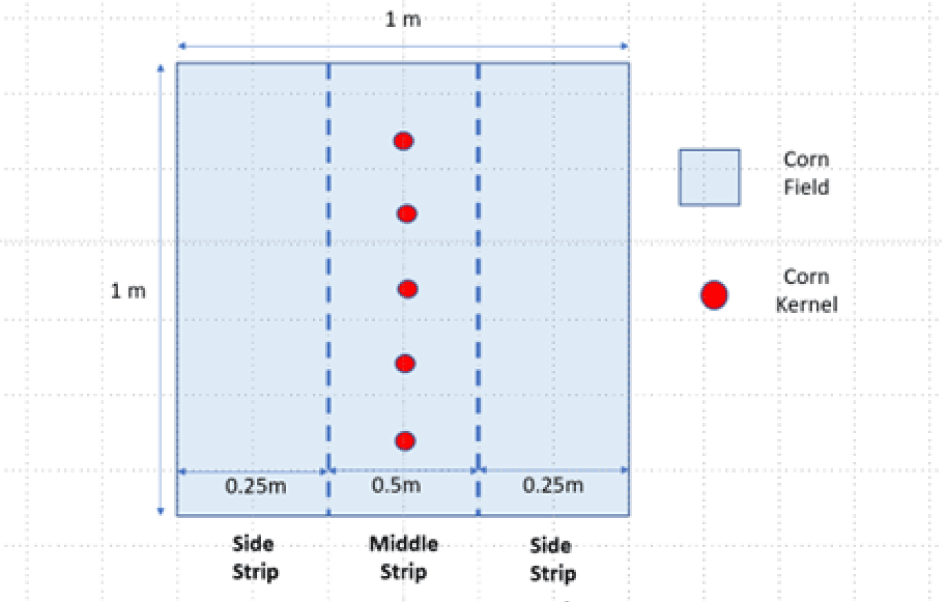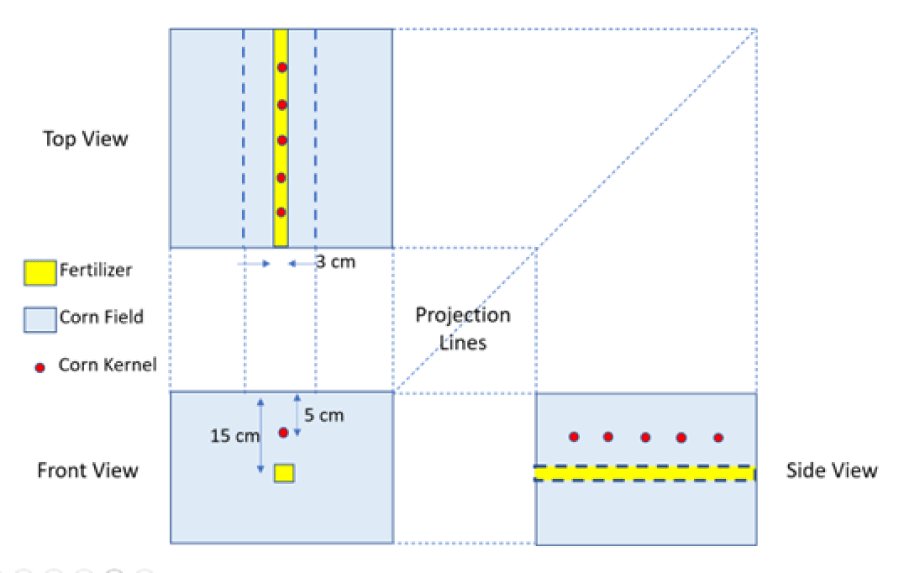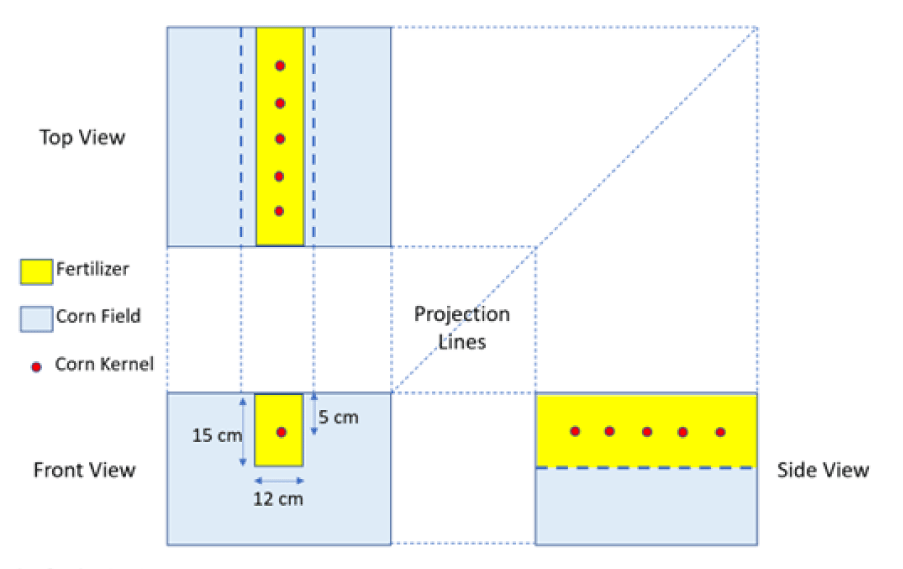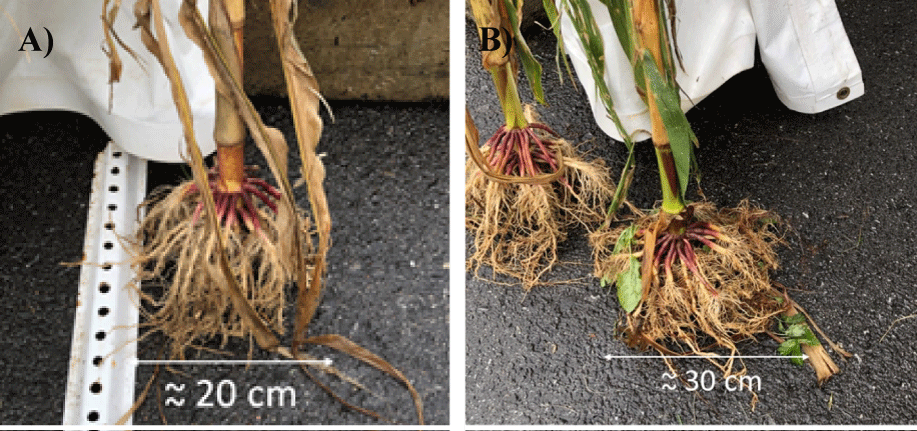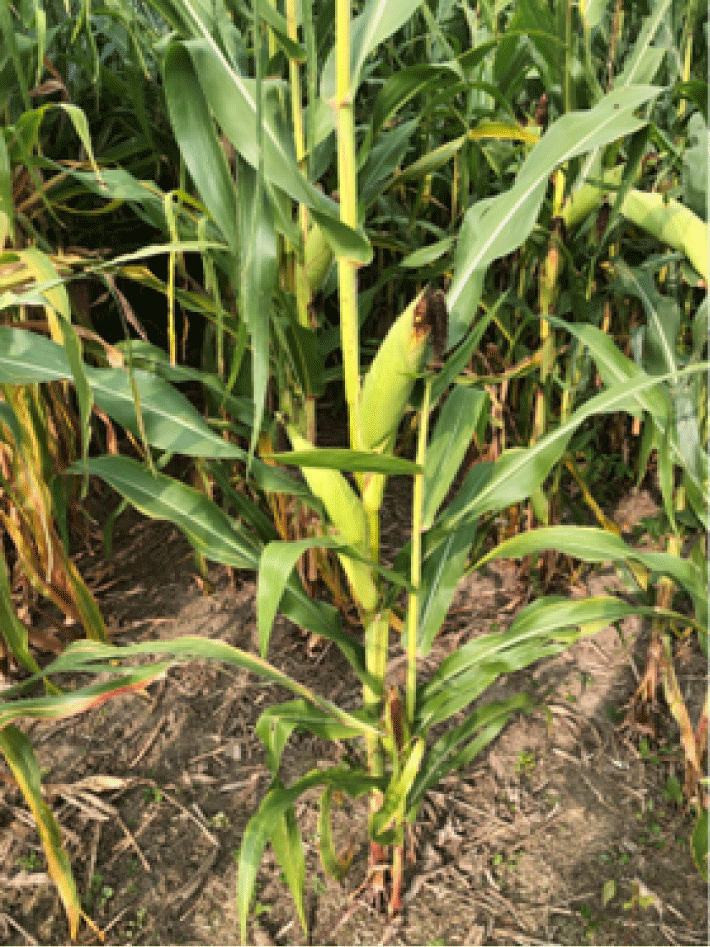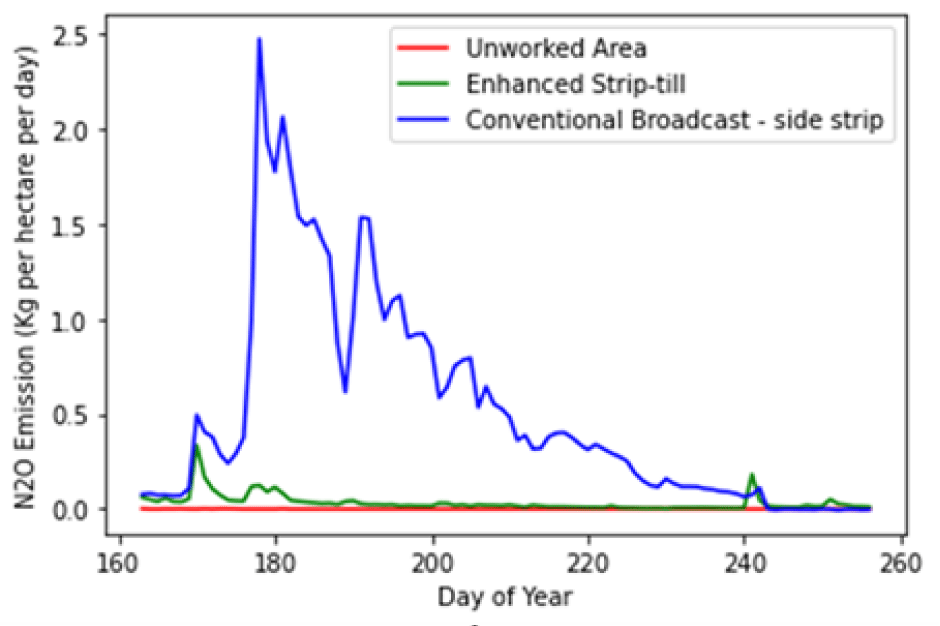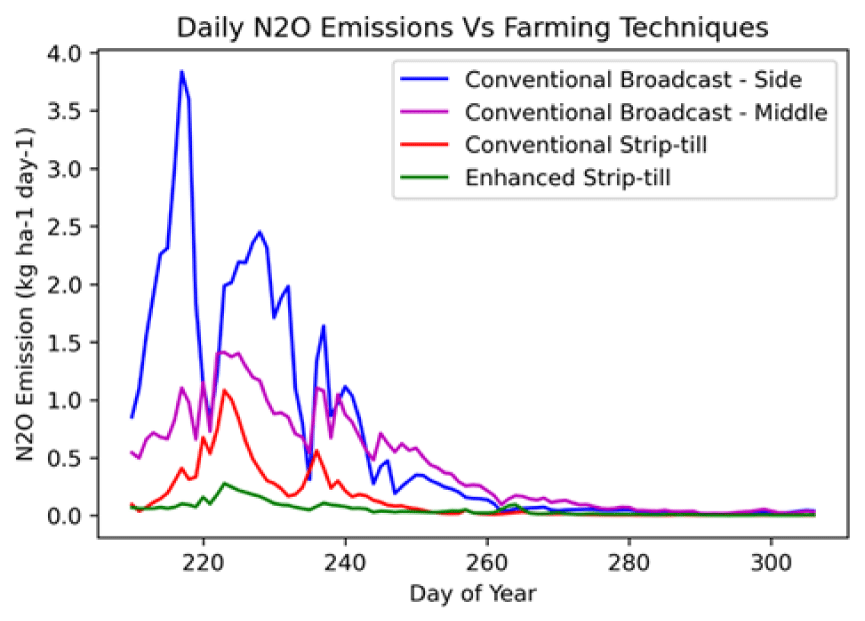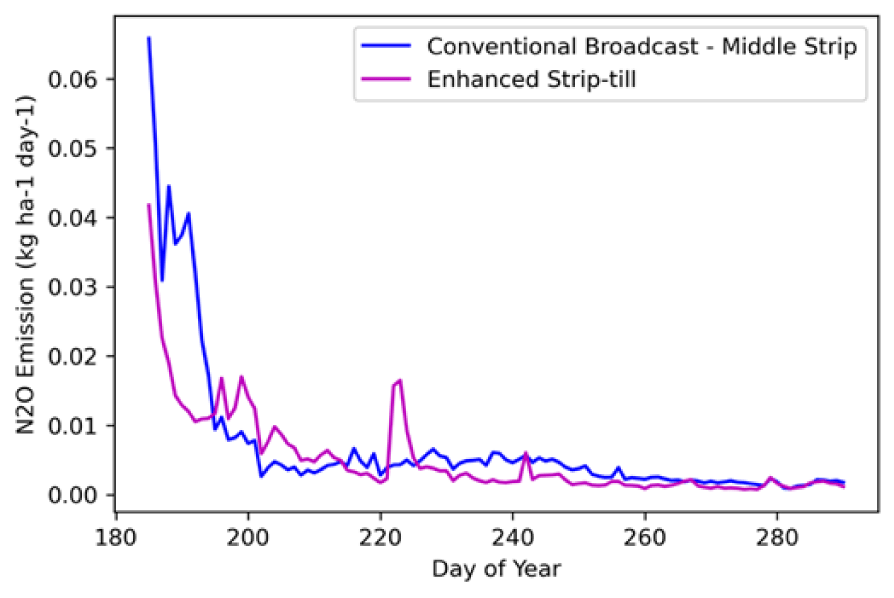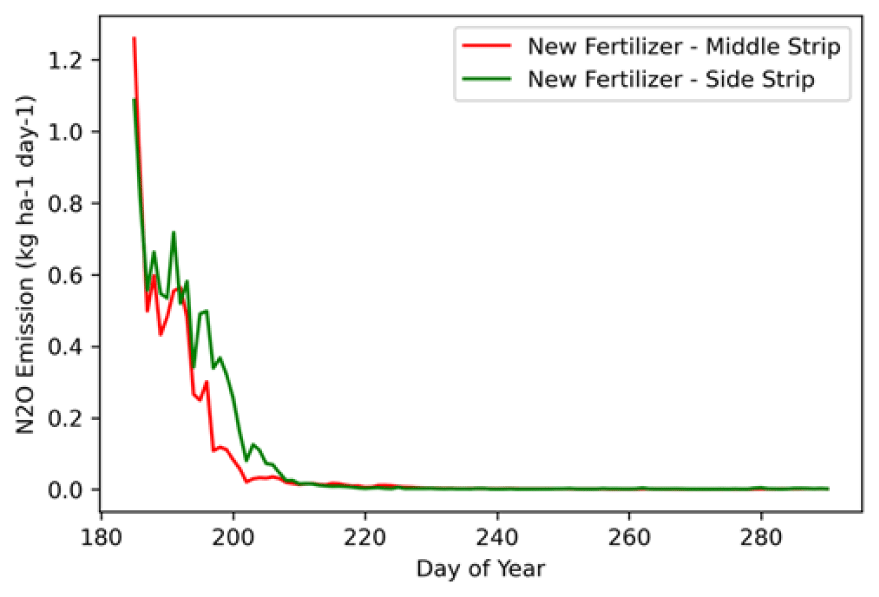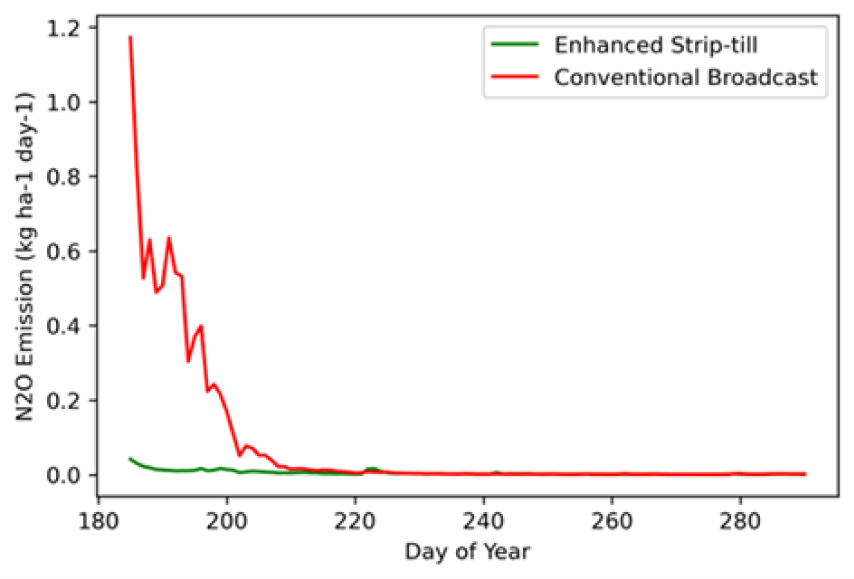Evironmental Sciences Group. 2024 June 06;5(6):519-536. doi: 10.37871/jbres1922.
Sustainable Agriculture: Mitigating Greenhouse Gas Emissions through Enhanced Strip-Tilling
Tet Yeap*
Abstract
Agriculture plays a substantial role in greenhouse gas emissions, and finding environmentally friendly and economically viable practices is crucial for addressing climate change and ensuring the long-term sustainability of the farming industry. A modern farming practice called Enhanced Strip-till is introduced in this paper. Compared with the widespread Conventional Broadcast farming practice, the new farming practice can achieve more than a 90% decrease in nitrous oxide emissions, a 33% decrease in fertilizer use, and a 26% increase in yield. Adopting and promoting such a sustainable farming practice is essential for the agricultural sector to transition towards more environmentally friendly and economically viable models. It's a positive step forward in balancing food production with environmental conservation, aligning with the goals of sustainable agriculture and responsible resource management.
Introduction
Agriculture is a cornerstone of human civilization, providing sustenance and livelihoods for billions worldwide. However, its contributions to Greenhouse Gas (GHG) emissions have raised environmental concerns [1-3]. GHGs, including CO2 (Carbon Dioxide), CH4 (Methane), and N2O s(Nitrous Oxide), contribute to the greenhouse effect, exacerbating climate change. Agriculture accounts for a substantial portion of these emissions, with N2O emissions predominantly originating from fertilizer use [4,5]. Excess nitrogen in soil triggers microbial processes that produce N2O, a potent greenhouse gas with a warming potential 300 times greater than CO2 [6,7]. Additionally, N2O is the single greatest ozone-depleting substance currently emitted, contributing to the degradation of the ozone layer which protects the Earth from harmful ultraviolet radiation [8]. Logically, we must investigate and adopt agricultural practices that mitigate harmful emissions while ensuring food security and economic viability.
Recognizing the urgency of addressing agricultural emissions, governments worldwide have set ambitious reduction targets [9]. Canada aims for a 30% reduction in N2O emissions from farming, while the Netherlands targets a 50% reduction by 2030 [10-14]. These targets underscore the imperative for sustainable agricultural practices to curb emissions while ensuring efficient and profitable food production [15].
Mitigating N2O emissions poses significant challenges due to the complex interplay of soil, fertilizer, and microbial processes. Traditional farming practices like the Conventional Broadcast often produce emission hotspots, necessitating innovative solutions [16]. The Enhanced Strip-till farming practice discussed in this study represents a shift in approach, offering a holistic method for achieving emission reduction.
The Enhanced Strip-till farming practice integrates precision agriculture techniques with conservation practices to optimize soil health, nutrient management, and emissions reduction. It is also known as the Fertilizer Mixed Throughout Strip, where the fertilizer is mixed uniformly into the soil along the planting strips, helping to optimize nutrient distribution for crop growth while minimizing the risk of over-fertilization in certain areas[17,18]. Unlike the Conventional Broadcast farming practice, which disturbs the entire field, strip-tilling minimizes soil disturbance by creating narrow strips for planting, leaving the remaining soil undisturbed. The Enhanced Strip-till farming practice allows for the precise placement of fertilizers directly into the planting zone, thereby minimizing nitrogen exposure to soil microbes and reducing N2O emissions. It enhances soil fertility and water retention by preserving soil structure and organic matter, promoting microbial diversity and activity without excessive nitrogen runoff. Despite reduced fertilizer use, the Enhanced Strip-till farming practice has been shown to maintain or even improve crop yields, ensuring profitability for farmers while mitigating environmental impacts.
The paper's objectives are twofold. The first is to collect N2O emission data for different farming practices and external conditions. This objective included collecting comprehensive data about nitrous oxide emissions from various farming practices under different environmental conditions. It involved conducting field experiments, monitoring N2O fluxes, and recording relevant ecological parameters such as soil type, moisture levels, and temperature. Additionally, data collection considered external factors such as weather patterns and land management practices to provide a holistic understanding of N2O emissions in agricultural settings. The second objective is to investigate whether the Enhanced Strip-till farming practice is more effective than the Conventional Broadcast and conventional Strip-till farming practices. This objective compares the effectiveness of different farming practices, specifically Enhanced Strip-till, Conventional Broadcast, and conventional Strip-till methods, relating to N2O emissions and other material parameters such as crop yield, soil health, and economic viability. The investigation involved experimental studies, statistical analyses, and modeling approaches to assess each farming practice's relative benefits and drawbacks. Additionally, factors such as resource efficiency, environmental impact, and scalability were considered to determine the overall effectiveness of the Enhanced Strip-till farming compared to other widely practiced methods. These research objectives provide a structured framework for conducting comprehensive studies on N2O emissions and farming practices. The studies aim to inform decision-making processes for promoting sustainable agriculture and mitigating environmental impacts.
Real-world implementations of the Enhanced Strip-till farming practice have demonstrated its efficacy in reducing N2O emissions while enhancing agricultural productivity. Three-year studies have documented a 90% reduction in N2O emissions, reduced fertilizer inputs, and increased yields, validating its potential as a sustainable farming practice.
Section 2 of this paper presents an overview of the Ottawa Smart Farm. Farming practices deployed at Area X.O. are described in Section 3, and the nitrous oxide experimental setup is described in Section 4. Experimental observations are presented in Section 5. Sections 6 and 7 present the innovative farm experimental yield and nitrous oxide emissions results from the Area X.O experiments conducted in 2021, 2022, and 2023. Section 8 compares greenhouse gas emissions from the Conventional Broadcast and Enhanced strip-till farming practices, highlighting the observed environmental benefits of adopting more sustainable agricultural methods. Finally, the study's conclusions, implications of the findings, and suggestions for future research are discussed in Section 9.
About area X.O. - Home of the ottawa smart farm
The Ottawa Smart Farm is part of a pioneering research and demonstration initiative operated by Invest Ottawa. It is on a 1,866-acre property in the heart of Ottawa that repurposes a former federal agricultural research facility. Invest Ottawa spearheads this innovative Smart Farm project with the City of Ottawa, FCC, the University of Ottawa, and GPS Ontario. It serves as a hub for cutting-edge technologies in agriculture, integrating autonomous systems, sensors, Internet of Things (IoT) devices, telecommunications infrastructure, big data analytics, robotics, drones, and Connected And Autonomous Vehicles (CAVs).
Located within the Area X.O V2X Living Lab and Test Facility, the Ottawa Smart Farm leverages 100 acres of farmland plus five smaller demonstration fields, 2-5 acres each, to provide a controlled environment for testing, validation, and demonstration of various agricultural innovations. The site is fully fenced and gated, ensuring privacy and security, making it Canada's largest secure facility dedicated to farming and smart mobility technology development.
The Ottawa Smart Farm's infrastructure is unparalleled, featuring world-class communication test infrastructure. It encompasses a broad spectrum of communication solutions, including GPS (RTK), Dedicated Short-Range Communications (DSRC), Wi-Fi, 4G/LTE, private LTE, LoRa, TV whitespace, and 5G technologies (including mm-Wave), establishing it as one of the most advanced communications test environments globally.
This facility empowers stakeholders such as producers, researchers, innovators, and companies to collaborate and innovate in intelligent agriculture. By leveraging technology, stakeholders can develop, test, validate, and demonstrate innovative agricultural solutions and Best Management Practices (BMPs). These efforts aim to enhance various aspects of farming operations, including cost and production efficiency, crop yield and quality, waste management, environmental sustainability, and overall farm management. The Ottawa Smart Farm endeavors to drive advancements that benefit farmers and the broader agricultural industry through data-driven decision-making.
Farming Practices
The choice of farming practices and fertilizer placement depends on soil conditions, climate, crop type, equipment availability, and the farmer's yield, sustainability, and resource efficiency goals [3].
Conventional full-till and no-till farming practices are often compared regarding crop production and their effects on soils and the environment. No-till farming has many benefits, including reduced erosion risk. However, in some places in Canada, like Ontario, no-till can be challenging for some crops, especially corn, due to cool and wet spring conditions. Likewise, full-till farming provides early-season soil warming and drying but can degrade soil over time and leave it vulnerable to erosion from water and wind. It is also labor and fuel-intensive.
Many farmers have recently sought a middle ground between full-till and no-till farming practices: strip-till. By maintaining strips of untilled soil amidst tilled ones, farmers can harness the advantages of both practices while mitigating their respective drawbacks. One key advantage of strip-till is its ability to provide early-season soil warming and drying, akin to conventional broadcast with full tillage. This is crucial for specific crops like corn, which require optimal soil conditions for germination and growth. This can be especially beneficial in regions with cool, wet springs like Ontario, where ensuring timely planting is essential for maximizing yields.
Strip-till farming offers the soil conservation benefits associated with no-till practice by leaving significant portions of the soil undisturbed between the tilled strips. This helps to prevent erosion from water and wind, preserving soil structure and fertility in the long term.
Advancements in equipment technology, particularly in precision agriculture tools like GPS systems, have facilitated the adoption of strip-till farming. These innovations allow for more precise and efficient tillage strips and fertilizer placement, enhancing strip-till farming. This minimizes soil disturbance while maximizing the benefits of both full-till and no-till practices. Overall, strip-till farming represents a pragmatic approach to soil management that addresses the challenges faced by Ontario farmers. It offers a balance between soil conservation and crop productivity. As technology evolves, strip-till farming will likely become an increasingly attractive option for farmers seeking sustainable and efficient agricultural practices.
This paper compares three farming practices: Conventional Broadcast with Full-till, Conventional Strip-till, and Enhanced Strip-till. The following describes how each practice was executed:
Conventional broadcast farming practice
Fertilizer is spread uniformly across the field and worked into the soil to a 3 to 5 cm depth. Corn kernels are placed at the same depth. This method can lead to inefficiencies because the plants may not fully utilize fertilizer applied between rows. The steps involved are as follows:
- Tillage for Soil Aeration: This involves mechanically manipulating the soil to improve its structure and increase air exchange in the soil profile. It helps in root growth, microbial activity, and overall soil health.
- Tillage to Prepare the Seedbed: This is the soil preparation process for planting seeds. It involves tilling the soil to break up clumps, remove weeds, and create a smooth, loose surface for seeds to germinate and establish roots.
- Broadcasting Fertilizer: Broadcasting fertilizer spreads fertilizer evenly over the soil surface. This method is often used for granular or powdered fertilizers and can be done manually or with machinery.
- Tillage to Incorporate Fertilizer into the Soil: After broadcasting fertilizer, tilling the soil helps incorporate the fertilizer into the soil profile, ensuring that nutrients are available to plant roots and preventing nutrient runoff.
- Planting of a Crop: This step involves sowing seeds seedlings into the prepared seedbed. Proper planting depth and spacing are crucial for optimal crop growth and yield.
- Optional Rolling of the Field: Rolling the field is done for various purposes, including creating seed-to-soil contact, firming the soil around seeds, and leveling the surface for uniform crop emergence. It can also help with weed control and moisture retention.
As the area between rows receives the same amount of fertilizer as the rows themselves, potentially leading to wasted resources and uneven crop growth.
Conventional strip-till farming practice
This is also known as Fertilizer Released At a 6-inch depth behind the shank or Deep Banding, where fertilizer is placed deeper in the soil behind the shank during planting[3][18]. This method mitigates safety risks associated with surface application, such as fertilizer runoff or accidental contact with machinery. However, one drawback is that it might compromise the immediate availability of nutrients to the plant, potentially affecting the starter fertilizer effect.
Narrow strips or rows are tilled in the ground before planting, leaving the area between the rows undisturbed. Fertilizers are typically injected into the tilled area during the strip-tilling operation. The steps involved are as follows:
- First pass: The soil is strip-tilled, aerated, and amended with fertilizers in a trench to create an optimal environment for plant growth. This pass is crucial for preparing the soil to provide essential nutrients and a suitable texture for germinating seeds and plants to thrive.
- Second pass: the seeds are planted at the appropriate depth and spacing for optimal growth. This ensures that seeds are placed above a well-prepared soil bed, maximizing their germination chances and establishing robust root systems.
Placing fertilizer at the bottom of the trench could lead to fertilizer concentration or "hotspots" and may cause root burn. Also, by separating these tasks into two passes, farmers can better customize each step to the specific needs of their crops, leading to potentially higher yields and healthier plants. Additionally, it allows for better timing of operations, especially in regions with distinct growing seasons or weather patterns.
Enhanced strip-till farming practice
Narrow (typically 6x6 inch) troughs are tilled before planting, with the fertilizer blended into the trench [17,19]. Similar to conventional strip-till, fertilizer is placed where the seeds are planted. The area between the strips are left undisturbed. The steps involved are as follows:
- One-Pass Soil Preparation: The process begins with a single pass over the field, during which the soil is worked into a light, fluffy seed bed. This preparation is crucial for ensuring optimal seed-to-soil contact, which promotes uniform germination. In this same pass, the required fertilizer is placed and blended into the strip, creating a nutrient-rich zone supporting early plant development.
- Second pass for Quick Turnaround for Planting: Within 24 to 48 hours of soil preparation, the field is ready for planting. This rapid turnaround time is essential for maintaining soil moisture levels and reducing the window for weed competition. Minimizing the time between soil preparation and planting ensures that seeds benefit from the freshly prepared seed bed and applied nutrients.
Enhanced Strip-till farming practice achieves crop growth with only two passes over the field—one for soil preparation, fertilizer application, and one for planting. This reduction in field passes saves time and labor and minimizes soil compaction and fuel usage. A key advantage of this method is creating a perfect seed bed. The light, fluffy soil structure ensures that all seeds are evenly covered and have consistent access to moisture and nutrients. This leads to uniform seed germination and emergence, critical for achieving high crop yields.
One unique aspect of the enhanced strip-till method is that the soil between the rows remains untouched. This preservation of soil structure supports ongoing microbial activity, which is vital for nutrient cycling and soil health. The undisturbed soil between the strips allows microbial populations to thrive, enhancing soil fertility and plant health.
Increased worm activity is another significant benefit. Worms are crucial in breaking down organic matter and recycling nutrients into the soil. Worms create channels in the soil, which improve aeration and water infiltration. By following worm channels, plant roots can penetrate deeper into the soil. This deep rooting enables plants to access moisture reserves during dry spells, reducing the impact of drought conditions. During late summer dry periods, such as those in July and August, corn can continue to grow and remain healthy because their roots reach where water is still available.
In addition, the channels created by worms act as natural surface drains, quickly moving excess water away from the soil surface during heavy rains. This reduces the risk of water-logging, which can drown crops. Efficient drainage ensures crops are not exposed to prolonged periods of excess moisture, which can damage root systems and reduce yields.
Thus, the Enhanced Strip-till farming practice significantly reduces the number of passes over the field, lowering fuel consumption and labor costs. This efficiency reduces the carbon footprint of farming operations and makes the method more economically viable for farmers. Also, by minimizing soil disturbance, this approach promotes sustainable farming practices. Preserving soil structure and enhancing microbial and worm activity contribute to long-term soil health. These benefits support a more resilient agricultural system that can withstand environmental stresses.
Summary
In summary, while conventional broadcast farming remains the most common, conventional and enhanced strip-till practices offer potential advantages regarding fertilizer application efficiency and overall crop health. Enhanced strip-till agriculture is the most promising in optimizing resource use and minimizing environmental impact.
Nitrous oxide emissions measurement
Experimental setup: To set up the experiment, a LICOR chamber was placed in one-square-meter planting zones [20,21]. Corn was the crop used for these experiments. Each one-square-meter planting zone was divided into three strips, two side strips, each with a width of 0.25 meters, and one middle strip with a width of 0.5 meters. The corn kernels were evenly placed in rows within the middle strip with 10 to 12-centimeter spacing.
The placement of fertilizers within these strips determined the type of farming practice. The following describes how the fertilizer was applied to emulate the three (17) different farming techniques investigated:
Conventional broadcast: Fertilizer was spread uniformly across the 1 square meter of the planting zone and worked into the soil to a depth of 3 to 5 cm. Corn kernels were then placed at the same depth. A projected view of the experimental plot is shown in figure 1.
Conventional strip-till: This technique aims to minimize soil disturbance and conserve moisture by only tilling the strip where the seeds will be planted. Therefore, a 0.5 m wide center strip was tilled, with the area between the strips left undisturbed. The fertilizer was injected into the tilled area during the strip-tilling operation by placing the fertilizer in a 15 cm deep and 2.5 cm wide channel at the bottom of the trench. A projected view of the experimental plot is shown in figure 2.
Enhanced strip-till: This technique also aims to minimize soil disturbance and conserve moisture by only tilling the strip where the seeds will be planted. A 12 cm wide and 15 cm deep trench is cultivated before the crop is planted, with the area between the strips left undisturbed. Unlike the Conventional Strip-till farming practice, the Enhanced Strip-till farming practice blends the fertilizer evenly into the trench. A projected view of the experimental plot is shown in figure 3.
LICOR nitrous oxide gas measurement equipment
The LICOR soil gas measurement equipment measures, records, and processes precise soil gas fluxes with minimal environmental disruption[20]. It consists of three parts:
- One LI-7820 N2O/H2O Trace Gas Analyzer
- One LI-8250 Multiplexer
- Four LI-8200-104 Opaque Long Term Gas Chambers
The following is a summary of the setup for monitoring trace gases in an outdoor environment:
- Equipment Encasement: The trace gas analyzer and multiplexer are enclosed within a Keter outdoor storage box for protection against environmental elements such as rain, dust, and sunlight, as shown in figure 4 [22].
- Ventilation: A hot air exhaust outlet and cold air inlet have been implemented to ensure proper ventilation and prevent equipment overheating. This helps maintain optimal operating temperatures for the instruments.
- Protection Against Intrusion: Wire mesh screens are installed in the inlet and outlet pipes to prevent small animals or insects from entering the box. This helps protect the equipment from damage or interference caused by unwanted intruders.
- Instrument Placement: The LI-7820 N2O / H2O Trace Gas Analyzer and LI-8250 Multiplexer are placed within the protective box. The LI-7820 N2O/H2O Trace Gas Analyzer and LI-8250 Multiplexer are placed within the protective box. These instruments measure trace gases such as nitrous oxide (N2O) and water vapor (H2O) concentrations in the air, as shown in figure 4. This setup ensures that the trace gas analysis equipment is adequately protected from environmental hazards while allowing proper ventilation and operation. It's crucial for maintaining the accuracy and reliability of the measurements, especially in outdoor settings where conditions can vary widely.
As noted, the measurements were done with an automated 4-chamber multiplexer system (LICOR LI-8250) and an N2O gas analyzer (LICOR LI-7820). Four gas chambers were placed in the order shown below, each emulating different farming practices. For example, in the year 2022, the chambers were arranged in the following:
- Chamber 1: Placed on the side strip using Conventional Broadcasting
- Chamber 2: Placed on the middle strip using Conventional Broadcasting
- Chamber 3: Placed on the middle strip using Conventional Strip-tilling
- Chamber 4: Placed on the middle strip using Enhanced Strip-tilling
Physics to measure nitrous oxide emission
Researchers can create a comprehensive dataset that captures the temporal and spatial variability of N2O emissions by conducting sequential flux measurements at regular intervals across multiple locations and farming practices. This allows for a detailed examination of how different factors influence emissions, such as soil type, crop type, fertilizer application rates, irrigation methods, and tillage practices.
Analyzing this data can reveal seasonal patterns in N2O emissions, such as spikes during high rainfall or after fertilizer application. It can also help identify which farming practices are associated with higher or lower emissions, providing valuable guidance for farmers, policymakers, and environmental scientists.
Moreover, by saving the data in a CSV file format daily, researchers enable easy access and analysis using various statistical and visualization tools. This facilitates the exploration of trends, correlations, and patterns over time, contributing to a deeper understanding of the underlying processes driving N2O emissions in agricultural systems.
Overall, this approach offers a powerful means of quantifying and characterizing N2O emissions, ultimately supporting efforts to develop more sustainable and climate-resilient agricultural practices.
The N2O flux from each chamber is collected and calculated using the following equation:
where F N2O represents the soil N2O flux, measured in nano moles per square meter per second (nmol.m2.s-1), V is the chamber volume in cubic meters (m3), P denotes atmospheric pressure in Pascals (Pa), R is the gas constant, measured in Pascals per cubic meter per mole per Kelvin , S stands for soil area in square meters (m2), T represents temperature in degrees Kelvin, is the rate of N2O change during the chamber closure, measured in nano moles per square meter per second ( ).
Methodology to measure nitrous oxide emission
In one square meter of farmland, two side strips and one middle strip occupy 50% and 50% of the land, respectively. Nitrous oxide emission for a particular farming practice could be measured by placing the LI-8200-104 Opaque Long Term Gas Chambers on one of the side strips and the middle strip. The total nitrous oxide emitted from the land due to a farming practice could be calculated using the following equation:
For the Conventional and Enhanced strip-till farming practices, we can assume that the nitrous oxide emission due to the side strip is zero. The above equation can be reduced to the following:
Experimental Observations from 2021 to 2023
Corn crop root formation and growth (using the Conventional Broadcast Farming Practice)
Corn and most grain crops are typically planted uniformly across the field in strips. However, the Conventional Broadcast farming method uniformly applies nutrients (fertilizer) across the entire field, including the area between crop rows.
In Conventional Broadcast farming, the fertilizer applied between crop rows may not be efficiently absorbed by the plants compared to the fertilizer applied directly in the strips where the plants grow. This leads to uneven fertilizer utilization, affecting crop growth and yield.
The observed root system of corn plants planted using the Conventional Broadcast farming practice had an average diameter of 20 cm, as shown in figure 5a. This demonstrates where the roots can effectively absorb nutrients, emphasizing the importance of targeted fertilizer application to maximize nutrient uptake and crop productivity.
Due to fertilizer distribution in conventional broadcast farming, only a small percentage of plants may produce two cobs per plant, while the majority may have only one cob. This cob formation habit can impact overall yield and crop quality.
Compared to Strip-Till (both conventional and enhanced), these factors underscore the benefits of more precise and targeted fertilizer application to optimize nutrient utilization, minimize waste, and improve crop productivity in traditional farming systems.
Corn crop root formation and growth (Enhanced Strip-till)
There are demonstrated advantages for the Enhanced Strip-till farming practice over the Conventional Broadcast farming practice, particularly regarding fertilizer application efficiency, root development, and crop yield, as evidenced below.
In Enhanced Strip-till farming, fertilizers are blended evenly into a trench at a depth of 15 cm and width of 12 cm, providing a more targeted and uniform distribution of nutrients than Conventional Broadcast farming. This ensures that the fertilizer is evenly distributed and available around the corn roots, promoting efficient nutrient uptake and minimizing waste. The root system of corn plants planted using the Enhanced Strip-till farming practice was denser and broader, with a diameter of 30 cm, as shown in figure 5b, compared to a 20 cm root system under the Conventional Broadcast farming practice. This denser and more comprehensive root system enhances nutrient and water absorption from the soil, improving plant growth and productivity.
Enhanced Strip-till farming demonstrated higher cob mass and overall yield than Conventional Broadcast farming. This is attributed to the more effective nutrient uptake facilitated by the denser root system and the increased fertilizer density created by the fertile root zone of this farming practice. The ability of Enhanced Strip-till farming to support the growth of two corn cobs per plant further contributes to increased yield potential.
Despite applying only 150 kg/ha of urea fertilizer, Enhanced Strip-till farming achieved higher fertilizer density, supporting the growth of two corn cobs per plant [23,24]. This resulted in more than 60% of corn plants producing two cobs, as shown in figure 5, demonstrating the effectiveness of those farming practices in maximizing crop yield potential.
Overall, the Enhanced Strip-till farming practice demonstrated several advantages, including improved fertilizer efficiency, enhanced root development, and increased crop yield, making it a promising approach for sustainable and high-yield agriculture.
Corn Yield Results (2021 2023)
2021 Yield results
Three farming practices were investigated in the 2021 planting year:
- Conventional Broadcast Location: Field 1 of Area X.O. Fertilizer amount: 225 kg/ha
- Conventional Strip-till Location: Field 3 of Area X.O. Fertilizer amount: 225 kg/ha
- Enhanced Strip-till Location: Fields 2 of Area X.O. Fertilizer amount: 150 kg/ha
The differences in corn size resulting from three farming practices: Enhanced Strip-till, Conventional Strip-till, and Conventional Broadcast are presented in the following:
- Corn Mass Comparison: Corn cobs grown using the Enhanced Strip-till farming practice were demonstrated to be 81.6% more massive than those grown using the Conventional Broadcast farming practice. Additionally, corn cobs grown using the Conventional Strip-till farming practice were demonstrated to be 23.7% more massive than those grown using the Conventional Broadcast farming practice. This suggests that Enhanced Strip-till and Conventional Strip-till methods result in larger corn cob sizes than corn grown using the Conventional Broadcast farming practice.
- Fertilizer Usage: Despite producing larger corn cobs, the Enhanced Strip-till farming practice also utilized 33.3% less fertilizer than Conventional Broadcast and Conventional Strip-till farming practices. This indicates the potential for the Enhanced Strip-till farming method to be more efficient in fertilizer usage and achieving higher crop yields, thereby improving productivity while reducing input costs. These findings highlight the potential benefits of Enhanced Strip-till farming practices, including increased crop mass and improved fertilizer efficiency. The data suggests that Enhanced Strip-till offers a more sustainable and economically viable approach for corn production than traditional farming methods like Conventional Broadcast and Conventional Strip-till. Table 1 provides valuable insights into the corn yield obtained from different farming practices, particularly Enhanced Strip-till, Conventional Broadcast, and Conventional Strip-till, along with their corresponding fertilizer usage. The data reveals the following:
- Enhanced Strip-till vs. Conventional Broadcast: Corn yield from the Enhanced Strip-till farming practice was demonstrated to be 32.8% higher than that from the Conventional Broadcast farming practice. This increased yield was achieved despite applying 33.3% less fertilizer in the Enhanced Strip-till compared to the Conventional Broadcast. The significant improvement in yield with reduced fertilizer input underscores the efficiency and effectiveness of Enhanced Strip-till practices in maximizing productivity.
- Conventional Strip-till vs. Conventional Broadcast: When the same amount of fertilizer is used, the corn yield resulting from Conventional Strip-till farming practices is only slightly higher than the yield from Conventional Broadcast farming practices. This suggests that Conventional Strip-till farming methods may not significantly enhance yield compared to Conventional Broadcast practices under similar fertilizer application conditions. Overall, these findings demonstrated the improved performance of the Enhanced Strip-till farming practice in terms of both yield increase and fertilizer efficiency when compared to Conventional Broadcast and Conventional Strip-till methods. Enhanced Strip-till offers a promising approach for sustainable agriculture, enabling higher crop yields while reducing input costs and environmental impact.
| Table 1: Crop yield as demonstrated by comparing 2 farming practices. | |||
| Farm Practice | Fertilizer Decrease | Yield (kg/ha) | Yield Increase |
| Conv. Broadcast | Base | 6923 | Base |
| Conv. Strip-till | 0% | 7315 | 5.7% |
| Enhanced Strip-till | 33% | 9194 | 32.8% |
2022 Yield results
Two farming practices were investigated in 2022:
- Conventional Broadcast Location: Field 3 of Area X.O. Fertilizer amount: 225 kg/ha
- Enhanced Strip-till Location: Fields 1 and 2 of Area X.O. Fertilizer amount: 150 kg/ha
A notable contrast in corn crop yield between the Enhanced Strip-till and Conventional Broadcast farming practices was observed. Specifically, the corn produced through Enhanced Strip-till is 67% more massive than that grown through Conventional Broadcast. Remarkably, this yield increase is achieved using 33.3% less fertilizer in the Enhanced Strip-till method.
This observation suggests that Enhanced Strip-till farming practices are not only more efficient in terms of fertilizer usage but may also result in significantly higher crop yields. This could be attributed to more precise fertilizer placement, better soil nutrient management, or other innovative techniques incorporated into the Enhanced Strip-till approach.
These findings highlight the potential benefits of adopting advanced farming practices, such as Enhanced Strip-till, for optimizing agricultural productivity and sustainability.
Based on the information provided in table 2, the corn crop yield resulting from the Enhanced Strip-till farming practice was 17% higher than the corn crop yield from the Conventional Broadcast farming practice. This increased yield was also achieved using 33.3% less fertilizer in the Enhanced Strip-till method than the Conventional Broadcast method.
| Table 2: Crop yield as demonstrated by comparing 2 farming practices. | |||
| Farm Practice | Fertilizer Decrease | Yield(kg/ha) | Yield Increase |
| Conv. Broadcast | Base | 7868 | Base |
| Enhanced Strip-till | 33% | 9213 | 17.1% |
These results imply that the Enhanced Strip-till method may lead to higher crop yields and demonstrate its potential for improved fertilizer efficiency compared to the Conventional Broadcast method. Further, these results underscore the potential benefits of adopting advanced farming techniques, such as Enhanced Strip-till, to enhance agricultural productivity and overall sustainability.
2023 Yield results
Experiments: The results of the investigations conducted in 2021 and 2022 demonstrated that the Enhanced Strip-till farming practice outperformed both Conventional Strip-till and Conventional Broadcast farming practices in crop yield and fertilizer efficiency. The Enhanced Strip-till farming practice achieved this by utilizing 33% less fertilizer while still showing an average yield increase of 25% compared to conventional methods.
Also introduced into the 2023 Planting study was using fertilizer inhibitors to reduce N2O emissions. These inhibitors are compounds added to nitrogen-based fertilizers to mitigate losses and improve plant nitrogen uptake efficiency. There are two main types of inhibitors:
- Urease inhibitors: These inhibitors are used when the active nitrogen component of the fertilizer is urea-N. Urease inhibitors work by slowing down the conversion of urea into ammonia, thus reducing the potential for ammonia volatilization losses.
- Nitrification inhibitors: These inhibitors are used when the active nitrogen component of the fertilizer is ammonium-N. Nitrification inhibitors work by slowing down the conversion of ammonium into nitrate, thereby reducing the potential for nitrate leaching and denitrification losses.
By extending the time that the active nitrogen component remains in the soil in either urea-N or ammonium-N form, inhibitors can help improve plant nitrogen uptake efficiency and minimize environmental emissions associated with nitrogen fertilizers. This may contribute to more sustainable agricultural practices through reduced environmental impact. In our 2023 study, we integrated additional experiments into our plan to investigate the following:
1. Experiment A: Studying the yield of corn using the Conventional Broadcasting farming practice:
(a) Location: Field 3 of Area X.O.
(b) Fertilizer: Urea and polymer-coated urea. The timing distribution was 40% instant urea and 60% polymer-coated urea, providing 30 days of delay activation.
(c) Fertilizer amount: 225 kg/ha
2. Experiment B: Studying the yield of corn using the Enhanced Strip-tilling farming practice:
(a) Location: Fields 6a of Area X.O.
(b) Fertilizer: Urea and polymer-coated urea. The timing distribution was 40% instant urea and 60% polymer-coated urea, providing 30 days of delay activation.
(c) Fertilizer amount: 150 kg/ha
3. Experiment C: Studying the yield of corn using the Enhanced Strip-tilling farming practice:
(a) Location: Fields 6b of Area X.O.
(b) Fertilizer: Urea coated with IPCO Nitrolizer [25]. IPCO Nitrolizer is a concentrated liquid fertilizer additive that can be used on urea. It contains thiophosphoric triamide, a urease inhibitor that inhibits the enzymatic activity of urease. By inhibiting urease enzyme activity, conversion from urea to ammonia is delayed, and ammonia losses from volatility are minimized.
(c) Fertilizer amount: 150 kg/ha
Crop yield results of experiments A and B: The observations, data, and analysis highlight the demonstrated benefits of the Enhanced Strip-till farming practice compared with the Conventional Broadcast farming practice regarding crop (corn) yield and cob mass.
Table 3 further demonstrates the efficiency of the Enhanced Strip-till farming practice, showing a 30% higher corn yield compared to the Conventional Broadcast farming practice, again utilizing 33.3% less fertilizer.
| Table 3: Crop yield as demonstrated by comparing 2 farming practices. | |||
| Farm Practice | Fertilizer Decrease | Yield(kg/ha) | Yield Increase |
| Conv. Broadcast | Base | 11926 | Base |
| Enhanced Strip-till | 33% | 15505 | 30% |
The root formation analysis depicted in figure 4 provides insight into the mechanisms underlying the observed yield differences. Corn grown under Enhanced Strip-till practices develops a more comprehensive (30 cm) and denser root system when compared to Conventional Broadcast (20 cm). This enhanced root system facilitates better absorption of nutrients and water from the soil, contributing to improved crop growth and yield and may support greater plant resilience. However, this has not been specifically analyzed.
In summary, the Enhanced Strip-till farming practice's success in achieving higher corn yield and cob mass could be attributed to its promotion of a denser and wider root system, enabling more efficient nutrient and moisture uptake. These findings emphasize the importance of innovative agricultural practices for enhancing crop productivity while minimizing resource inputs.
Yield results of experiments B and C: Experiments B and C were designed to assess the impact of using different fertilizers, conventional urea versus urea coated with IPCO neutralizer, using the same Enhanced strip-till farming practice [25]. Both experiments applied the same amount of fertilizer: 150 kg/ha. The results of these experiments, as presented in table 4, indicate that corn fertilized using urea coated with IPCO nitrolizer exhibited a smaller cob mass and yield than corn treated with conventional urea fertilizer.
| Table 4: Crop yield resulting from two different types of fertilizer following the same planting and fertilizing practice. | |||
| Fertilizer | Mass Per Cob | Yield(kg/ha) | Yield Increase |
| Urea | 385 | 15505 | Base |
| Urea with Inhibitor | 360 | 14361 | -7.4% |
These observations suggest that, in this particular context and experimental setup, the conventional urea fertilizer outperformed the urea coated with IPCO neutralizer regarding overall crop yield (corn yield and cob mass). Further analysis and investigation are necessary to understand the underlying factors contributing to this outcome, such as the efficiency of nutrient release, uptake, or any potential interactions between the coated urea and soil conditions.
It is worth noting that while coated fertilizers like the IPCO neutralizer may offer benefits such as controlled release and reduced nutrient losses, their efficacy can vary depending on multiple factors, including soil type, climate, crop type, and application method. Thus, the results of Experiments B and C underscore the importance of evaluating different fertilizer options in specific agricultural contexts to optimize crop productivity and sustainability.
Nitrous Oxide Emissions Measurement Results
2021 Nitrous oxide emissions results
Nitrous oxide emissions were measured using an automated 4-chamber multiplexer system (LICOR LI-8250) coupled with an N2O gas analyzer (LICOR LI-7820), as described earlier in this paper. The location of this experiment is at the west end of Field 2 at Area X.O. The N2O flux emission data was collected over Fifty-eight days (June 11th, 2021, to August 8th, 2021).
For this experiment, four (4) gas chambers were placed as noted in the order shown below, each measuring the emissions from different farming practices.
- Chamber 1: Placed on a nearby field emulating a natural unworked area.
- Chamber 2: Placed on the strip emulating the Enhanced Strip-till farming practice, 150kg/ha of urea and polymer-coated urea fertilizer were applied.
- Chamber 3: Placed on the strip emulating the Conventional Broadcast farming practice (with crop), 225 kg/ha of urea and polymer-coated urea fertilizer were applied.
- Chamber 4: Placed on the strip emulating the Conventional Strip-till farming practice (with crop), 225 kg/ha of urea and polymer-coated urea fertilizer were applied.
The measured data highlights several key findings from the experiments conducted:
- Exclusion of conventional strip-till data: The measured result for the Conventional Strip-till farming practice was deemed erroneous and excluded from the analysis due to the absence of plant growth near the LICOR chamber. This underscores the importance of reliable data collection and ensuring proper experimental conditions.
- Partial data for conventional broadcast: The measured result for the Conventional Broadcast farming practice could only be applied to the side strip due to the lack of plant growth near the LICOR chamber. This limitation necessitated a focused analysis on the side strip only.
- Baseline emission measurement: The N2O emission from an unworked area was close to zero, serving as a natural baseline emission. This confirms that the LICOR chamber and equipment functioned as expected, validating the accuracy of emission measurements.
- Comparison of N2O emissions: Figures 5 and 6 demonstrate significant differences in N2O emissions between the Conventional Broadcast and Enhanced Strip-till farming practices. Enhanced Strip-till practices resulted in lower N2O emissions, attributed to the efficient absorption of nitrogen by plant (corn) roots due to more even fertilizer distribution. This reduces the volatility of N2O gases and minimizes unused fertilizer conversion into N2O, benefiting both the environment and farmers through sustainable agriculture practices.
- Quantification of N2O emissions: Approximately 48.2 kg of nitrous oxide per hectare per season was emitted from the side strips of Conventional Broadcast farming practices, compared to only 3.2 kg per hectare per season from Enhanced Strip-till practices. Furthermore, an unworked area resulted in negligible N2O emissions, highlighting the impact of agricultural practices on greenhouse gas emissions.
These findings underscore the importance of investigating sustainable agricultural practices such as Enhanced Strip-till farming to mitigate greenhouse gas emissions while maintaining or even enhancing crop productivity.
2022 Nitrous oxide emissions results
As described earlier, nitrous oxide emissions were measured with an automated 4-chamber multiplexer system (LICOR LI-8250) coupled with an N2O gas analyzer (LICOR LI-7820). The experimental location is near the west end of Field 2 in Area X.O. Ninety days (July 29th, 2022, to October 27th, 2022) of data on N2O emissions were collected. Note that data collection occurred later than expected because of technical problems with the LICOR equipment.
Four gas chambers are placed in the order shown below, each emulating different farming practices.
- Chamber 1: Placed on the strip emulating the Conventional Broadcast farming practice (with crop), 225 kg/ha of urea and polymer-coated urea fertilizer were applied.
- Chamber 2: Placed on the strip emulating the Conventional Broadcast farming practice (without crop), 225 kg/ha of urea and polymer-coated urea fertilizer were applied.
- Chamber 3: Placed on the strip emulating the Conventional Strip-till farming practice (with crop), 225 kg/ha of urea and polymer-coated urea fertilizer were applied.
- Chamber 4: Placed on the strip emulating the Enhanced Strip-till farming practice (with crop), 150 kg/ha of urea and polymer-coated urea fertilizer were applied.
The observations made from the N2O emissions data provide valuable insights into the environmental impacts and efficiency of different farming practices:
- Enhanced Strip-tilling farming practice demonstrates lower N2O emissions than Conventional Broadcasting and Conventional Strip-tilling practices, as shown in figure 7 . The even distribution of fertilizers around corn roots in Enhanced Strip-tilling promotes efficient nitrogen absorption, reducing N2O volatility. This benefits the environment and enhances profitability by reducing input costs while potentially increasing corn yield.
- The significant N2O emissions observed in the Conventional Broadcast farming practice, particularly from the side strip, highlight the environmental consequences associated with this method. The similarity in response between the side strip and the scenario with no crop in figure 6 underscores the detrimental impact of inefficient fertilizer application.
- Comparatively, Conventional Broadcast farming results in higher N2O emissions than Conventional Strip-till farming, indicating the latter's potential environmental advantage.
- Based on the calculations and equations provided, the Conventional Broadcast farming practice is estimated to generate approximately 63.3 kg per hectare per season of N2O emissions from the side strip and 41.4 kg per hectare per season from the middle strips.
- In contrast, the Conventional Strip-till farming practice yields lower N2O emissions, estimated at 13.7 kg per hectare per season, as depicted in figure 8. This amount is notably lower (approximately 7.6 times less) than the N2O emissions from the Conventional Broadcast farming practice, reflecting the environmental benefits of strip-till methods.
- Remarkably, the Enhanced Strip-till farming practice results in even lower N2O emissions, estimated at only 4.9 kg per hectare per season, as depicted in figure 8. This emission amount is significantly reduced compared to both the Conventional Broadcast (approximately 21.4 times less) and Conventional Strip-till (approximately 2.8 times less) farming practices, highlighting the effectiveness of Enhanced Strip-till in mitigating greenhouse gas emissions.
In summary, the observations underscore the importance of implementing sustainable agricultural practices like Enhanced Strip-till, which reduces environmental impacts and offers potential economic benefits for farmers.
2023 Nitrous oxide emissions results
As described earlier in this paper, nitrous oxide emissions were measured with an automated 4-chamber multiplexer system (LICOR LI-8250) coupled with an N2O gas analyzer (LICOR LI-7820). The experimental location is near the west end of Field 2 of Area X.O. One hundred and five days (July 7th, 2023, to October 18th, 2023) of data on N2O emissions were collected. Four gas chambers are placed in the order shown below, each emulating different farming practices.
- Chamber 1: Placed on the strip using the Conventional Broadcast (with crop); 150kg/ha of urea and polymer-coated urea fertilizer was applied.
- Chamber 2: Placed on the strip using the Enhanced Strip-till, 150kg/ha of urea and polymer-coated urea fertilizer was applied.
- Chamber 3: 225 kg/ha of urea coated with a urease inhibitor was applied to the strip using the Conventional Broadcast (with crop).
- Chamber 4: Placed on the strip using the Conventional Broadcast (without crop); 225 kg/ha of urea coated with urease inhibitor was applied.
Chambers 1 and 2 in this study examine how different farming practices affect nitrous oxide emissions. The focus is on comparing the impact of farming practices while keeping the amount of fertilizer and soil condition consistent.
The Enhanced Strip-till farming practice demonstrated the production of two cobs per plant, with cob masses of 380 g and 300 g. Conversely, the Conventional Broadcasting farming practice shows the output of only one cob per plant, with a cob mass of 220 g. The comparison of cob mass is significant because it can indicate potential differences in crop yield and overall agricultural productivity between the two farming practices.
Figure 8 demonstrates that N2O emissions from the middle strip of Conventional Broadcast and Enhanced Strip-till farming practices are similar when an adequate amount of 150 kg/ha of fertilizer is used; it suggests that the efficiency of fertilizer consumption by the corn plant is comparable between the two methods under these conditions. The result implies that both Conventional Broadcast and Enhanced Strip-till methods can utilize fertilizers effectively, resulting in similar N2O emissions when an adequate amount of fertilizer is applied. Efficient fertilizer use is crucial for reducing N2O emissions, contributing to greenhouse gas emissions and climate change, optimizing agricultural productivity, and minimizing environmental impacts.
Chambers 3 and 4 study the impact of using urea coated with a urease inhibitor on nitrous oxide emissions when the widely used Conventional Broadcast farming practice is employed. The amount of new fertilizer applied is 225 kg/ha.
Figure 9 shows that the nitrous oxide emissions from the side strip are slightly higher than those observed from the middle strip. However, the emissions from the side strip were expected to be much higher. This difference in emissions could be attributed to weeds' dense growth around Chamber 4.
Notably, the nitrous oxide emissions from the middle strip are comparable to those from the same farming practice using conventional urea. This suggests that the new fertilizer may not significantly impact nitrous oxide emissions. However, it is essential to note that these observations are preliminary and do not provide a definitive conclusion regarding the new fertilizer. Further investigation is necessary to understand its impact on nitrous oxide emissions fully.
Additional research should be conducted to thoroughly assess and study the effects of the new fertilizer, considering factors such as different farming practices, environmental conditions, and variations in crop yields. This will help to provide a more comprehensive understanding of the relationship between the new fertilizer and nitrous oxide emissions.
The N2O emissions resulting from comparing the two different farming practices are shown in figures 10. The figures show that the N2O emissions from the Conventional Broadcast farming practices (both middle and side strips) are significantly higher than the N2O flux emissions from the Enhanced Strip-tilling farming practice, demonstrating that fertilizer in the Enhanced Strip-tilling farming practice is decomposed into nitrogen and is readily absorbed by corn roots, reducing the volatility of N2O gas. Only a small amount of fertilizers will be converted into N2O gas. This supports the hypothesis that enhanced strip-till farming may benefit the environment and help farmers with sustainable agriculture practices by reducing input costs and increasing yield profitability. Note that nitrous oxide emissions are 7 to 8 times lower than the previous year's result due to bumper crop yield in 2023 (Tables 2,3). Enhanced Strip-tilling facilitates the decomposition of fertilizer into nitrogen, which is efficiently absorbed by crop roots. Consequently, the volatility of N2O gas is reduced, resulting in lower emissions. The reduction in N2O emissions in the current year is attributed to a bumper crop yield in 2023, as indicated in tables 2 and 3. This suggests that crop yield variations can influence N2O emissions, emphasizing the need to consider multiple factors, including environmental conditions and farming practices, when assessing emissions.
Nitrous oxide emissions results summary
Table 5 summarizes N2O emissions data for different farming practices, highlighting the significant reductions that may be achievable with the Enhanced and Conventional Strip-till farming practices compared to the Conventional Broadcast farming practices. The three-year results indicate substantial reductions in N2O emissions, with the Enhanced Strip-till farming practice offering over a 90% reduction and the Conventional Strip-till farming practice offering over an 80% reduction compared to the Conventional Broadcast farming practice.
| Table 5: 3-year observed N2O emission reduction results from Conventional and Enhanced Strip-till farming practices in comparison to Conventional Broadcast farming practice. | |||
| Year | Conv. Broadcast | Conv. Strip-till | Enhanced Strip-till |
| 2021(Dry Year) | Base | X | -93.4% |
| 2022(Wet Year) | Base | 87% | -95.3% |
| 2023(Wet Year) | Base | No data | -93% |
The suggestion to repeat the 2022 N2O emissions experiment in 2024 aims to verify whether the Conventional Strip-till farming practice could be a viable option instead of the more widely used Conventional Broadcast practices. This approach emphasizes the importance of ongoing research and validation to assess the effectiveness of different farming practices to mitigate N2O emissions.
By replicating the experiment, researchers can assess the consistency of results over time and determine whether the Conventional and Enhanced Strip-till practices consistently demonstrate reduced N2O emissions compared to the Conventional Broadcast practice. This verification process is crucial for informing agricultural policy and guiding farmers toward adopting environmentally sustainable practices while maintaining productivity and profitability.
In summary, the proposed repetition of the N2O emissions experiment 2024 aims to validate the potential of
Conventional and Enhanced Strip-till farming practices as a sustainable alternative to Conventional Broadcast practices, contributing to the ongoing efforts to mitigate greenhouse gas emissions from agriculture (Figure 11).
Environmental Impact
The observed comparison between greenhouse gas emissions from Conventional Broadcast farming and Enhanced strip-till farming practices highlights the potential benefits of adopting more sustainable agricultural methods.
- Conventional Broadcast Farming practices: With this method, a hectare of farmland emits approximately 65.6 kg of nitrous oxide gas annually, equivalent to 19,680 kilograms of carbon dioxide. Given that about 1 million hectares of farmland are dedicated to growing corn, the total emissions from conventional broadcast farming are equivalent to the emissions from 4.27 million cars running on the road annually.
- Enhanced Strip-till Farming: This practice demonstrated reduced GHG emissions considerably. Suppose we assume an N2O reduction factor similar to that observed in our study (over 90% reduction from Enhanced strip-till compared to conventional broadcast farming), using a similar context as noted above. In that case, the emissions from growing corn using the Enhanced strip-till farming practice would be reduced to only 72 thousand cars running on the road annually.
- These comparisons underscore the importance of investigating and considering adjustments to more sustainable agricultural practices to mitigate greenhouse gas emissions. By transitioning to methods like enhanced Strip-till farming, farmers can reduce emissions from their operations and contribute to overall efforts to combat climate change. Similarly, moving to conventional strip-till, which is more prevalent, can also achieve a significant positive impact.
Conclusions
The farming experiments conducted in Area X.O., Ottawa, over three years (2021, 2022, and 2023) demonstrate the advantages of the Enhanced Strip-till farming practice over the Conventional Strip-till and Conventional Broadcast practices. Table 6 summarizes the key findings of these experiments:
| Table 6: 2021, 2022, and 2023 in field results when the Enhanced strip-till farming practice is compared with the conventional broadcast farming practice. | |||
| Year | Fertilizer Decrease | Yield Increase | N2O Emissions Decrease |
| 2021(Dry Year) | 33% | 32.8% | 90% |
| 2022(Wet Year) | 33% | 17.1% | 90% |
| 2023(Wet Year) | 33% | 30% | N2O 90% |
- Reduced Fertilizer Requirement: Enhanced Strip-till farming requires 33% less fertilizer than conventional farming practices. This reduction in fertilizer input contributes to cost savings and potentially reduces environmental impacts associated with fertilizer use.
- Increased Yield: Despite using less fertilizer, the Enhanced Strip-till farming practice delivers an average yield increase of 25% compared to conventional practices. This improvement in yield suggests enhanced efficiency in nutrient utilization and crop growth under the Enhanced Strip-till method.
- Measurable Reduction in Nitrous Oxide Emissions: Over the three years, the Enhanced Strip-till farming practice resulted in a more than 90% decrease in nitrous oxide emissions compared to conventional practices. This reduction in greenhouse gas emissions demonstrates the environmental sustainability of the Enhanced Strip-till method.
- The adoption of Enhanced Strip-tilling benefits the environment by reducing N2O emissions and offers advantages to farmers. These include lower input costs associated with fertilizer use and potentially increased yield profitability. Such practices align with sustainable agriculture principles, promoting environmental stewardship and economic viability.
Overall, the results suggest that adopting the Enhanced Strip-till farming practice offers a win-win solution for farmers, providing increased yield, profitability, and environmental benefits. These findings highlight the potential of innovative agricultural practices to address the challenges of sustainable food production and climate change mitigation.
As the global community grapples with climate change, sustainable agriculture emerges as a critical solution to mitigate greenhouse gas emissions. Strip-till farming offers a promising pathway toward achieving emission reduction targets while promoting soil health, biodiversity, and economic resilience in agriculture. By embracing innovative practices like the Enhanced Strip-till farming, we can cultivate a more sustainable and resilient future for agriculture and the planet.
Acknowledgment
We want to thank the research work by the staff of Invest Ottawa, supported by the City of Ottawa, FCC, and GPS Ontario. We also would like to thank the research funds provided by the MITACS and the Ontario Research Fund (GR003147). Furthermore, we thank graduate students Lin Ci, Futong Li, and Patrick Killeen for their input in several aspects of this work. Finally, early project funding from Fertilizer Canada is gratefully acknowledged.
References
- Stocker B, Roth R, Joos F, Spahni R, Steinacher M, Zaehle S, Bouwma, L, Prentice IC, Xu-Ri Xu-Ri. Multiple greenhouse-gas feedbacks from the land biosphere under future climate change scenarios. Nature Climate Change. 2013;3(7):666-672. doi: 10.1038/nclimate1864.
- Pandey D, Agrawal M, Pandey JS. Carbon footprint: current methods of estimation. Environ Monit Assess. 2011 Jul;178(1-4):135-60. doi: 10.1007/s10661-010-1678-y. Epub 2010 Sep 18. PMID: 20848311.
- 3.Pandey D, Agrawal M. Carbon footprint estimation in the agriculture sector. In Assessment of Carbon Footprint in Different Industrial Sectors. Springer. 2014:1. doi: 10.1007/978-981-4560-41-2_2.
- Montzka SA, Dlugokencky EJ, Butler JH. Non-CO2 greenhouse gases and climate change. Nature. 2011 Aug 3;476(7358):43-50. doi: 10.1038/nature10322. PMID: 21814274.
- Gruber N, Galloway JN. An Earth-system perspective of the global nitrogen cycle. Nature. 2008 Jan 17;451(7176):293-6. doi: 10.1038/nature06592. PMID: 18202647.
- Beeckman F, Motte H, Beeckman T. Nitrification in agricultural soils: impact, actors and mitigation. Curr Opin Biotechnol. 2018 Apr;50:166-173. doi: 10.1016/j.copbio.2018.01.014. Epub 2018 Feb 3. PMID: 29414056.
- Maag M, Vinther FP. Nitrous oxide emission by nitrification and denitrification in different soil types and at different soil moisture contents and temperatures. Applied Soil Ecology. 1996;4(1):5-14. doi: 10.1016/0929-1393(96)00106-0.
- Ravishankara AR, Daniel JS, Portmann RW. Nitrous oxide (N2O): the dominant ozone-depleting substance emitted in the 21st century. Science. 2009 Oct 2;326(5949):123-5. doi: 10.1126/science.1176985. Epub 2009 Aug 27. PMID: 19713491.
- Ussiri D, Lal R. The role of nitrous oxide on climate change. In Soil Emission of Nitrous Oxide and its Mitigation. Springer. 2013;1-28. doi: 10.1007/978-94-007-5364-8.
- Deng SX. Assessment of greenhouse gas emissions from agriculture in Canada: A Comparative Analysis. 2022.
- Arias P, Bellouin N, Coppola E, Jones R, Krinner G, Marotzke J, Naik V, Palmer M, Plattner GK, Rogelj J. Climate change 2021: The physical science basis. Contribution of working group14 i to the sixth assessment report of the intergovernmental panel on climate change; technical summary. 2021.
- Galloway J, Dentener F, Capone D, Boyer E, Howarth R, Seitzinger S, Asner G, Cleveland C, Green P, Holland E. Nitrogen cycles: Past, present, and future. Biogeochemistry. 2004;70(2):153-226, 2004. doi: 10.1007/s10533-004-0370-0.
- Worth D, Lemke R, McConkey B, Pennock D, Wagner-Riddle C, Rochette P, RJ Desjardins. Estimation of n2o emissions from agricultural soils in Canada. I. Development of a country-specific methodology. Canadian Journal of Soil Science, 88(5):641–654, 2008. doi: 10.4141/CJSS07025.
- Cavigelli M, Grosso S, Liebig M, Snyder C, Fixen P, Venterea R, Leytem A, McLain J. Watts D. Us agricultural nitrous oxide emissions: Context, status, and trends. Frontiers in Ecology and the Environment. 2012;10(10):537-546. doi: 10.1890/120054.
- Galloway JN, Townsend AR, Erisman JW, Bekunda M, Cai Z, Freney JR, Martinelli LA, Seitzinger SP, Sutton MA. Transformation of the nitrogen cycle: recent trends, questions, and potential solutions. Science. 2008 May 16;320(5878):889-92. doi: 10.1126/science.1136674. PMID: 18487183.
- Fowler D, Coyle M, Skiba U, Sutton MA, Cape JN, Reis S, Sheppard LJ, Jenkins A, Grizzetti B, Galloway JN, Vitousek P, Leach A, Bouwman AF, Butterbach-Bahl K, Dentener F, Stevenson D, Amann M, Voss M. The global nitrogen cycle in the twenty-first century. Philos Trans R Soc Lond B Biol Sci. 2013 May 27;368(1621):20130164. doi: 10.1098/rstb.2013.0164. PMID: 23713126; PMCID: PMC3682748.
- Agronomy guide for field crops. In: Brown C, editor. Queen’s Printer for Ontario; 2017.
- William RR, John BS, Gordon VJ, Marvin LS, Robert WM, Kyle WF, Wade ET, Erna VL. Improving nitrogen use efficiency in cerealgrainproduction with optical sensing and variable rate application. Agron J. 2002;94:815-820. doi: 10.2134/agronj2002.8150.
- Rosser B. Investigating fertilizer placement and safe fertilizer rates in strip till, field crop news. 2022.
- Licor environmental equipment.
- Trevor R, Dacres H. Analytical techniques for measuring nitrous oxide. TrAC Trends in Analytical Chemistry. 2014;54:65-74. doi: 10.1016/j.trac.2013.11.004.
- Keter outdoor deck boxes.
- Haynes RJ, Sherlock RR. Gaseous losses of nitrogen. Mineral Nitrogen in the Plant-soil System. 1986;242-302.
- Tisdale SL, Nelson WL, Beaton JD. Soil fertility and fertilizers. New York: Macmillan; 1985. doi: 10.5555/19851998321.
- Ipco nitrolizer.
Content Alerts
SignUp to our
Content alerts.
 This work is licensed under a Creative Commons Attribution 4.0 International License.
This work is licensed under a Creative Commons Attribution 4.0 International License.





